Pre-1800’s

The history of Coal Mining in Guernsey County goes back further than Euro-American settlers. Indians that once used Wills Creek for fishing, also knew of the great resource coal could be to keep warm throughout the winter. Before any mining operations were setup, veins throughout the county resulted in coal being on the surface. Early settlements found in the area were said to have proved the Native Americans use of the coal. You could literally pick it up off of the ground as easily as a rock. According to Dave Adair, the Guernsey County Historical Societies foremost coal mining historian, the Indians of the area did just that, collected the coal for fires and called it “rocks-that-burn.”
Pioneer Days—1800-1850
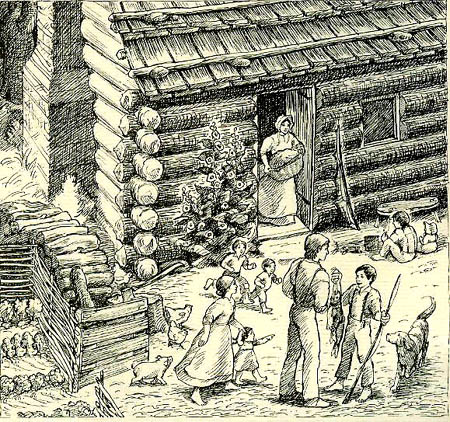
Despite the great amount of wood provided by our areas vast wilderness—there was so much wood trees had to be chopped down in order to plat the different surrounding towns—early settlers of the area, in the pioneer days, also made use of the abundance of coal. William G. Wolfe ponders that the first settlers must have found it a novelty, or at some point they must have found the coal was much easier and efficient to obtain than cutting down trees in times when labor and wood were scarce. Whatever the reason, farmers begun setting up “coal banks” where they would gather the easily accessible coal on their land for their own use or maybe even sold to neighbors for a little profit.
Industrial Revolution—1850-1870

C&M Group Picture
It wasn’t until technology such as steamboats and railroads were developed that these black rocks were seen as lucrative. In the 1840’s Trains and Steamboats had established themselves as premiere technologies that would catapult America on to the world scene of commerce and industry. Railroads were being developed along routes that were never considered previously as having any potential economically. Steamboats made rivers and the great lakes yet even more valuable for transporting commerce long distances. Guernsey County none-the-less was caught up in this great national phenomena known as the Industrial Revolution. Thus the demand and price for coal skyrocketed and here little old Guernsey County was with it literally bursting at its seems. In the 1850’s a series of mines were established. The first was on an old “coal bank” on the farm of George Scott sitting just east of Cambridge near the National Road (Route 40) between Lore City and Cambridge. The enterprise become so large it was no longer deemed a “coal bank” and the name was changed to the “Gaston Mine.” Following the Gaston Mine, the Scott Mine and the Norris Mines were established nearby. The location of the railroads alongside the mines made them extremely efficient and very profitable for investors.
In an interview with Dave Adair, I learned of a Ghost Town located where Reservoir Road meets the crossroads near Coal Ridge today. The town of Scotts was one of many towns established for keeping the miners near their work site and when the coal mines went out of business some years later, the location and the towns were completely and totally abandoned. Today there is almost nothing in the area to reflect the daily life of the miners. I cannot help but think of the men waking early, drinking coffee to start the day, going to the mine to work a tough shift, and then hitting a small tavern at the end. The different jokes and smiles they must have shared, the different daily toils that were common of the time, and the conflicts that might have arisen because of working rivals, different languages, or them being forced to live among each other in a small collection of buildings with nowhere to escape. All of this now long forgotten about with not a single trace of their lives and what they consisted of, all vanished by space and time.
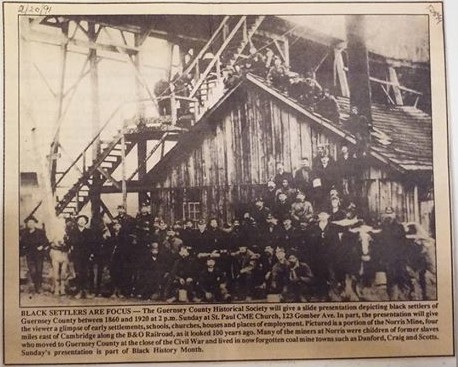
A Daily Jeffersonian article dated for February 20th, 1991 gives us insight into the early mines as a part of a piece for black history month, it reads as follows: BLACK SETTLERS ARE FOCUS — The Guernsey County Historical Society will a slide presentation depicting black settlers of Guernsey County between 1860 and 1920 at 2 p.m. Sunday at St. Paul CME Church, 123 Gomber Ave. In Part, the presentations will give the viewer a glimpse of ealry settlements, schools, churches, houses, and places of employment. Pictured is a portion of the Norris Mine, four miles east of Cambridge along the B&O Railroad, as it looked 100 years ago. Many of the miners at Norris were children and former slaves who moved to Guernsey County at the close of the Civil War and lived in some forgotten coal mine towns such as Danford, Craig, and Scotts. Sunday’s presentation is part of Black History Month.
The Norris Mine was the last of the early eastern Guernsey mines to be established in the 1850’s. It was also maybe the most financially successfully as we can see in the picture from the Historical Societies research room dated from the 1880’s, it was open for some time. Also I should note in a book about the history of African Americans in Guernsey County by Wayne L. Snider, and as documented in the newspaper clipping in the photograph, early African American communities were established near Four Mile hill by Lore City, and it was not until employment near Cambridge did they leave their residences and move into the county seat. The Coal Mines are likely the reason for these early segregated settlements in eastern Guernsey County. As were the small towns of the county established for people off all nationalities. In fact, in the book written by Russell Booth you can find a long list of different European nationalities that traveled to and worked in the Guernsey County Coal Mines, some coming from as far away as Russia. The very growth of surrounding towns like Byesville, Lore City, Kipling, Walhounding, Buffalo, Pleasant City and so on, owe their existence to the attraction of our coal mines.

A copy of the original photograph of the Norris Mine from the Historical Societies Research Room.

A closer look at the information given by the Historical Society, it reads as follows: “Norris Coal mine located near “MS” Telegraph Tower and South of the railroad seen in the background used a trestle to reach it’s opening approx. 300 yards away. “Bock and Berry” were used to (Shove/Pull) loaded cars away from the coal tipple. Photo dates circa 1890.”

Black Top Mine located near Lore City on Cherry Hill Road
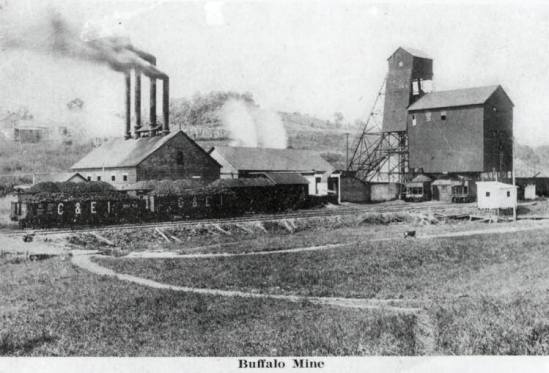
The Buffalo Mine
If you would like to see more pictures you can click this link to go to an album uploaded by Tom Severns to the Facebook group “You know You’re From Guernsey County When…”
The Gilded Age—1870—1920’s

Downtown Cambridge in front of the Courthouse
As wealth and civilization grew in the surrounding area’s so did wealth and civilization in the counties seat of Cambridge. After the Civil War the growing population of the area gives rise to a growing manufacturing and retail base. With a small amount of money to spend, immigrants from the surrounding coal mining towns would have traveled by horseback to Cambridge to buy things they could not otherwise buy in their small villages. Retail stores in Cambridge boom as a result, and with so much money pouring in to the area manufactures of glass and other industries are built and provide yet even more jobs and wealth and thus a row of extravagant mansions are erected along 7th Street. Despite the world growing in population by 700-800% since 1900, there were more people in Guernsey County then, than reside here now. Thus it is true, the manikins designed and put out on display each year by the Dickens Village folks, are truly an accurate representation of the people in Cambridge at its height in the Gilded Age. Cambridge is a classic Victorian era city. Our history is very reflective of the history of the entire nation. We were not much more than an outpost in the wilderness at the beginning, our area grew greatly with the industrial revolution and with the introduction of coal mining and technology, we reached our economical heights at the turn of the 1900’s. There was not a soul in the county that could not find work if they had a shred of virtue or ambition. A massive beautiful courthouse was erected, an elegant monument to salute veterans of the Civil War, there were multiple newspapers, and even a street car on Wheeling Avenue. Almost every town in the county owes its infrastructure to the coal mining era. All this growth and history from what the Indians once called “rocks-that-burn.”
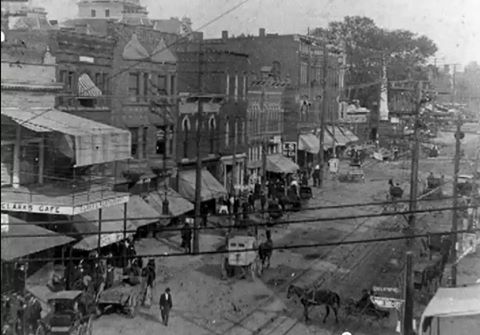
Coal Mining brought get wealth and prosperity to Guernsey County
Dave Adair’s Coal Mining Exhibit At The Guernsey County Museum

Dave Adair, whom I have mentioned a few times in this article, has worked long and hard to make a Coal Mine Exhibit at the Guernsey County Historical Society Museum. A part of the exhibit is a great collection of photographs documenting many of the different mines around the area. According to Dave, all told there were as much as 1,500 different coal operation sites within our county lines at one point or another. Some of the most prominent companies include: Cambridge Collieries, Akron Coal Company, and the Old National Coal Company. You should at some point come in and check out this exhibit, to get an idea of how influential the coal mines were to the development of your community. You get to experience firsthand the darkness and isolation these men must have felt working underground.
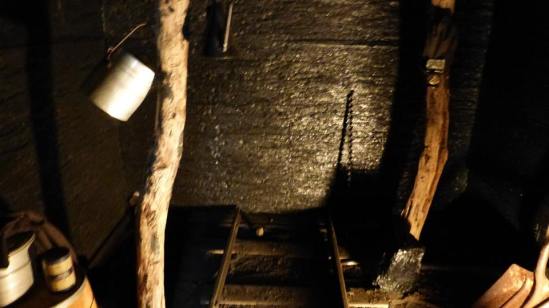
For Museum Opening and Hours for this summer you can click here.
Pingback: Guernsey County OH-Lakes, Lodges, and Living Drama - My Town Today
this is cool. I was looking for an ancestor who tried to sell PA anthracite in Philadelphia. He was a Metis, and his mother’s family had been using coal for metal work for generations. As I recall, he was arrested for trying to scam people and spent a night in the Walnut St. Penitentiary (the world’s first penitentiary). At court, he proved it burned, and burned hotter than charcoal. They let him got but he still had to pay for his night in jail–which was customary then. Yep, I put it on facebook for all my relation in Ohio to see. Merry Christmas!
LikeLike